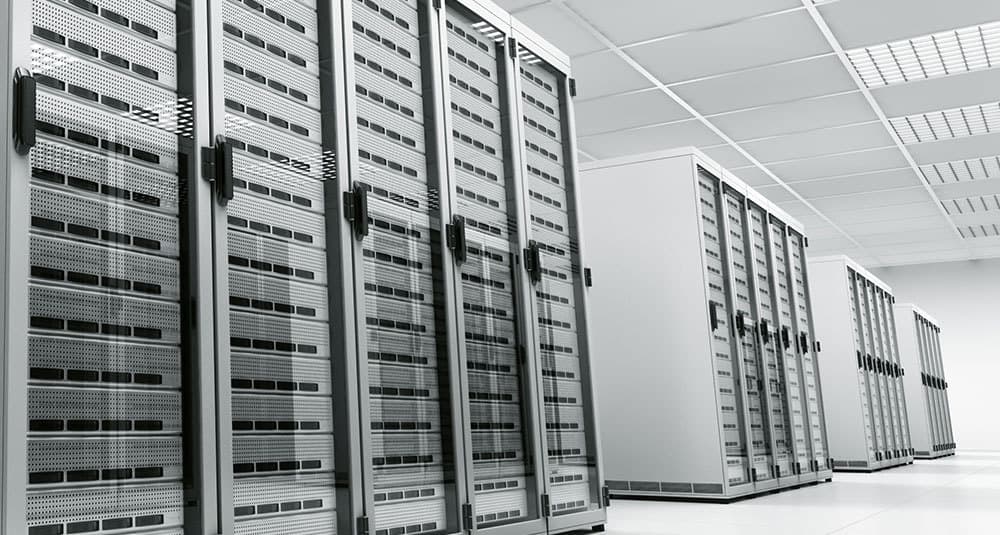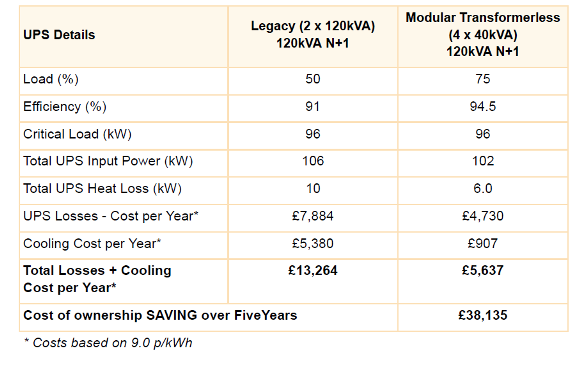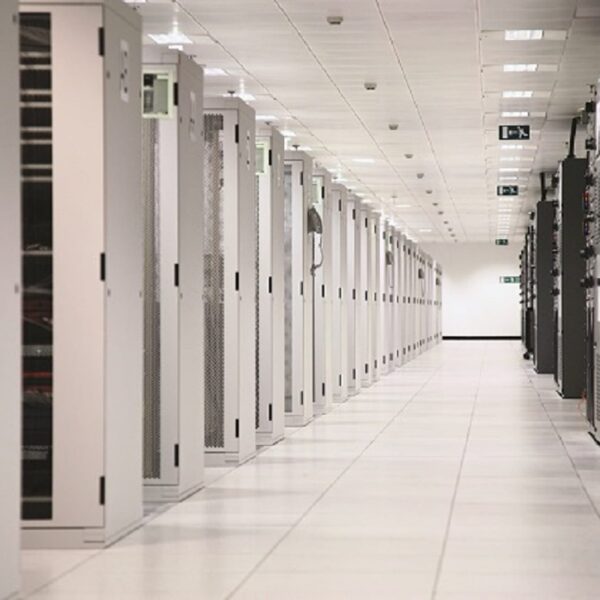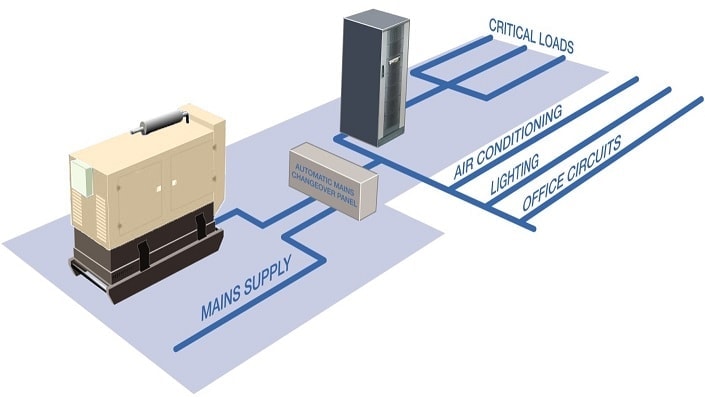When budgeting for uninterruptible power supply systems, it’s essential to consider the total cost of ownership rather than just the original purchase price. If operating costs and upgrades are taken into account, an apparently lower-cost initial purchase can often be ultimately more expensive for the purchaser than a better-technology solution with a slightly higher original price tag.
In this article, KOHLER Uninterruptible Power, a KOHLER company, explains how better UPS topology can reduce the total cost of ownership and improve reliability while doing so.
Most modern businesses’ reputation and survival depend ultimately on the quality and availability of their electrical power supply. Even brief power transgressions can take down any ICT equipment they reach, immediately disrupting any banking, purchasing or other transactions currently in progress. The Bank of England’s 2014 Q3 Bulletin notes that ‘Over 98% of sterling payments by value are made electronically….an (IT) infrastructure failure could greatly inhibit — or remove entirely — the ability of individuals and firms to make their payments. This would have severe consequences for economic activity’. The Bulletin cites power failures as a potential cause of such scenarios.
Any operator faced with this possibility wants the best UPS protection technology available, while being aware that any funding request will be closely scrutinised in today’s economic climate. Fortunately, however, there is an answer to this dilemma; consider the UPS’s total cost of ownership rather than simply its catalogue purchase price. The best-performing UPS technology will cost a little more to buy initially than older products, but within a year the higher cost of the modular system is recovered.
Although there are several reasons for this, they all relate to how UPS technology and topology have evolved. Accordingly we can look at this evolution and see how it generates cost-saving benefits alongside improved technical performance.
Improved efficiency cuts costs
Legacy systems used transformers, which made them large and heavy by today’s standards. For example a data centre with a 120kVA load could theoretically have been supplied by a single, floor-standing 120kVA UPS unit. In reality however, redundancy would probably be required to ensure better availability; this would be implemented with two 120kVA units sharing the load in a 1+1 redundant configuration. As a result, neither unit could ever be more than 50% loaded, which for a transformer-based system meant a significant reduction in efficiency. It also meant investing in substantially more UPS capacity than actually necessary.
The advent of transformerless technology has allowed much smaller and lighter UPS implementations – in fact to UPS modules that can be incrementally added to a racking frame to achieve an application’s required power capacity and redundancy. Free-standing individual units are no longer necessary. The 120kVA load of the above example could therefore be satisfied by a single rack containing four 40kVA ‘hot swap’ plug-in modules. The load remains fully supported with n+1 redundancy, while the total UPS capacity has been reduced from 240kVA to 160kVA.
Although the purchase price per kVA for modular UPSs will be slightly higher than for legacy types, this difference will be partly offset by the reduction in purchased capacity and in floor space required for installation. However important savings in operating costs will also be made as the modular solution is more efficient than a transformerless implementation – especially one that cannot operate at more than 50% loading. Table 1 below shows that for our 120kVA example, these savings will amount to over £38,000 for a five year operating period when the associated reduction in cooling costs is taken into account.
Table 1: Legacy vs. modular transformerless UPS: Comparative operating costs over five-year period
Although these savings alone will more than offset any difference in original purchase price, modular UPSs’ inherent efficiency can cut costs even further. Some UPSs are efficient enough to qualify for the Energy Technology List, or ETL. As part of the Enhanced Capital Allowance tax scheme for businesses, this government-managed list of energy-efficient plant and machinery includes UPSs as well as items such as boilers, electric motors and air-conditioning systems. A business that pays income or corporation tax can claim 100% first year capital allowance on any ETL-listed product purchased. The ETL’s accompanying Energy Technology Criteria List (ETCL) has a complete section on UPSs. This defines and describes UPS technology, including the criteria for ETL eligibility.
These ETCL criteria include UPS efficiency thresholds for eligibility at different percentages of full load for static systems of 10kVA or more.Transportation costs themselves can also be halved, and installation costs can be considerably reduced, by using the smaller, lighter modular technology.
During UPS operation, modular topology can also reduce ongoing costs due to spare part stock and logistics issues. Because traditional systems demand in-situ component-level repairs, maintaining a suitable set of spare parts is difficult and costly – especially as users tend to buy the most extensive and costly kit for maximum security. Even then, there is no guarantee that the kit obtained will be effective or contain the parts required for every possible failure that could arise.
Modular systems, however eliminate these complications. Instead a single spare plug-in module will suffice; even when modules of different power ratings are being used, simply holding a module of the highest kVA rating installed will cover all eventualities, Training is simplified and less time-consuming, and trained technicians can swap modules within 15 minutes. Repairing by module-swapping in this way can save up to 50% on logistics and stock management costs.
Modular system upgrading is also far simpler, faster and cheaper as extra capacity can be added simply by plugging in additional modules without even interrupting power to the critical load. The building work, increase in footprint and interruption to supply associated with extending traditional systems is eliminated.
Hot swap modules and their impact on UPS availability
So we can see that over time the modular solution becomes more attractive in cost terms – but does it compromise power availability by doing so? Not at all; in fact the reverse is true. A UPS’s availability is increased if its mean time to repair (MTTR) is reduced, and a key feature of a modular system is its minimal MTTR figure. If a hot swappable module does fail, it can be withdrawn from the UPS frame without even interrupting power to the load. A replacement module can be plugged into the rack immediately, reducing UPS repair time to as little as half an hour.
By contrast, if a legacy system fails, it must be shut down, isolated from its mains supply and repaired in situ; a process that typically takes 6 hours to complete. This factor means that whereas a transformer-based system can offer ‘five nines’ (99.999%) availability, a modular UPS provides ‘six nines’ (99.9999%) availability. ‘Five nines’ equates to 2.5 minutes’ downtime per year while ‘six nines’ equates to 32 seconds.
Conclusion
In today’s online commercial environment, power failures that bring down ICT systems are unacceptable, yet UPS systems, as significant capital equipment items, must be carefully cost-justified. Fortunately the best technology currently available need not be the most expensive, provided the total cost of its ownership is considered. In this article we have seen the technical, tax and logistics reasons why modular UPS technology, although initially slightly more expensive to purchase, becomes the most economical solution – while increasing UPS power availability – once all costs are taken into account.





